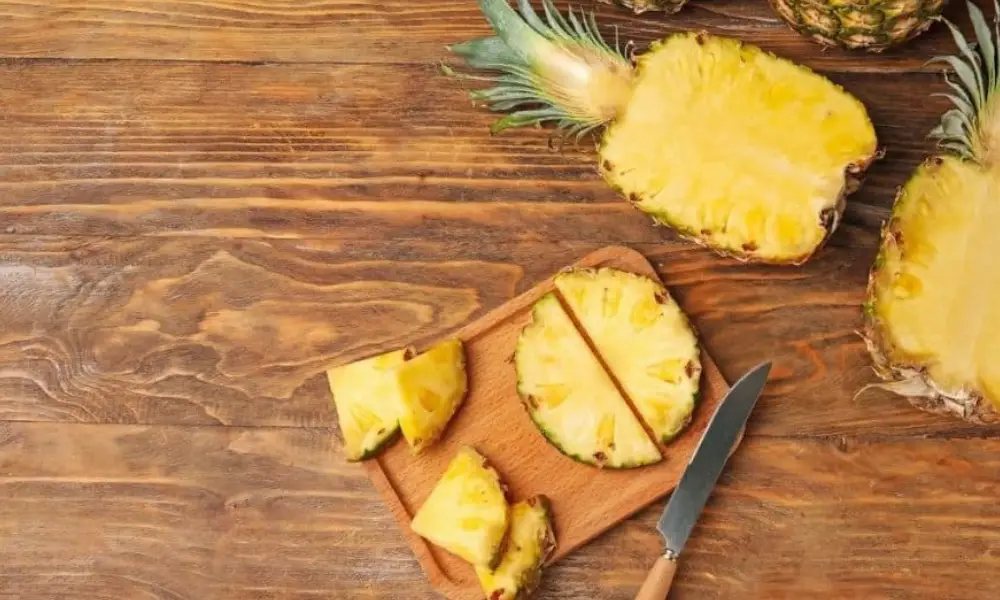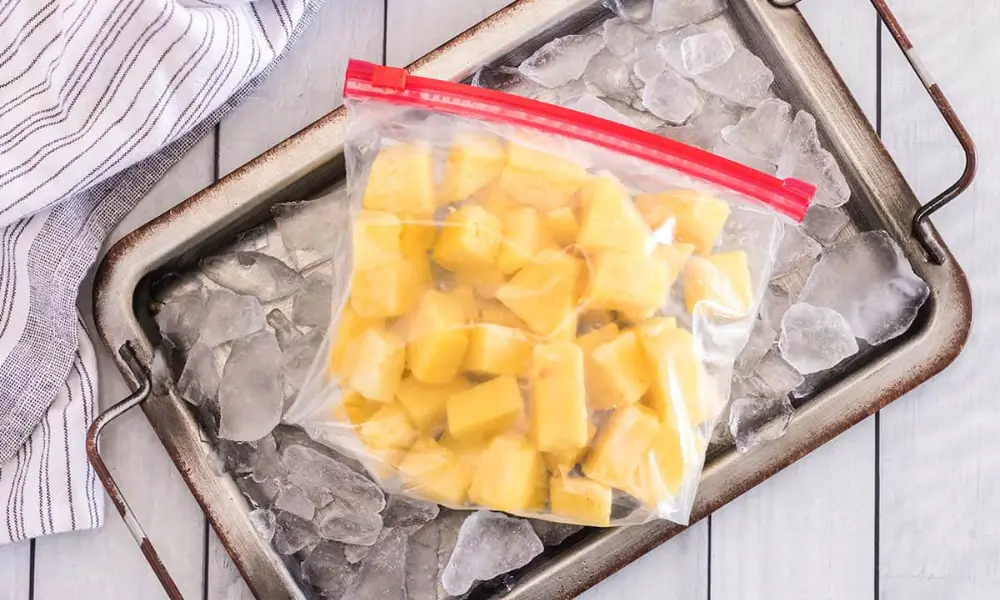One of the best ways to use pineapple is frozen. You can use frozen pineapple in various recipes, including smoothies, ice cream, and fruit salad. You can even freeze a pineapple for later use. Pureed pineapple is a great option because it holds up to freezing well. Just use a blender or food processor to puree your pineapple.
You can freeze pineapples, but ensure you do it as soon as possible. Pineapples can stay frozen for up to 6 months in the freezer, but you’ll need to check them regularly for signs of spoilage. Look for discoloration, mold, and odors to know if they’ve gone bad.

What is a Pineapple?
Tropical fruits like pineapples are rich in vitamins, enzymes, and antioxidants, which may help with stomach relief, a robust immune system, and strong bones. Despite being sweet, pineapples have few calories.
The bromeliad family includes pineapples, the only bromeliad to bear edible fruit, according to the Purdue University Center for New Crops and Plant Products. The fruit comprises numerous distinct berries that assemble around a nucleus. Every scale on a pineapple is a separate blossom or berry.
As enticing as their unique architecture, pineapples have nutritional advantages. According to San Diego dietician Laura Flores, pineapples are rich in manganese and vitamin C. These tropical fruits contain dietary fiber and the health-promoting compound bromelain (an enzyme).
How to Freeze Pineapple?
At room temperature, a completely ripe pineapple only lasts a few days. You can freeze pineapple if you’re not quite ready to eat it, increasing its shelf life to a year. Use these procedures to freeze an entire pineapple.
Cut the pineapple and core it. First, cut off the pineapple’s green top using a sharp chef’s knife. Slice off the pineapple’s bottom crosswise with your sharp knife so that it rests level on the cutting surface. Slice the pineapple in half lengthwise after removing the outer skin with your knife. Before cutting the pineapple into bite-sized pieces approximately the size of an ice cube, remove the core.
The pineapple pieces should be arranged on a baking pan. Use wax, parchment, or a silicone baking mat to line the baking sheet. On the prepared baking sheet, arrange the pineapple chunks in a single layer.
Flash-freeze the pineapple pieces. Place the baking sheet in the freezer for one to two hours, or until the cut pineapple is frozen. This will lessen the chance of the pineapple chunks sticking together when stored for a long time.
Keep pineapple that has been frozen in freezer bags. Fill freezer bags or any other freezer-safe, airtight container with the frozen pineapple pieces. In the freezer, frozen pineapple can be stored for up to a year.
Pineapple Freezing: 5 Tips
You can save up on this delightful summer fruit all year by freezing fresh pineapple. Consider a few suggestions to make the most of your frozen pineapple.
To coring quickly, use a pineapple corer. A kitchen tool called a pineapple core is made specifically for swiftly extracting the pineapple’s core. Before slicing and freezing the pineapple, remove the core with a pineapple core.
Individual pineapple servings should be frozen. Measure out your preferred serving size and freeze the pineapple pieces in separate bags to shorten the preparation time for smoothies.
Separately freeze the pineapple cores. The pineapple’s core has beneficial fiber and an enzyme called bromelain that is frequently included in dietary supplements. Although pineapple cores are too fibrous and rough to eat raw, you can easily freeze them and use them in juices and smoothies.
Before adding frozen pineapple to fruit salad, defrost it. Allowing frozen pineapple to rest in the refrigerator for an entire night will quickly defrost it. Then, for a cool side dish, combine the defrosted pineapple with a variety of other fresh fruits, like grapes, strawberries, mango, and watermelon. Save the pineapple juice for cocktails and baking, or discard it.
Use a storage container that can be frozen. A vacuum sealer is the best defense against freezer burn, which will drain the taste from your pineapple. Any freezer-safe container, though, will work. Use an airtight container made of glass, plastic, or plastic freezer bags for optimal results.
What Health Advantages do Pineapples Offer?
We can eat this fruit by slicing it or producing juice from it, and we all know how good it is for our general health. Here are a few pineapple health advantages that you should be aware of.
Treats a Cough and a Cold
Eat pineapple as soon as you can if you have a serious cold. This is due to the presence of bromelain, an enzyme with anti-inflammatory properties that can fight diseases and eradicate bacteria, in this beneficial fruit. If you consume it consistently, it can help you find against coughs and colds.
Bones Strengthening
Manganese can be advantageous when combined with zinc, copper, and calcium since it maintains bone strength. The high manganese content in pineapple is beneficial to your bones. Simply including this fruit in your diet can help you maintain a substantial body and strong bones.
Therefore, pineapple has all the components required for bone growth, which is why it helps support stronger bones.
Benefits for Teeth
Pineapple is said to strengthen gums and enhance general health. Pineapple has a significant calcium content, which is also present in your teeth and bones. Additionally, it includes manganese, which helps to strengthen bones and teeth. Drink pineapple juice every day to be healthy.
Cancer Prevention
It is said that eating one pineapple a day will prevent cancer. You only need to consume pineapple juice daily to reap its health benefits. The wonderful thing about this fruit is that it helps you look younger while reducing cell damage.
This fruit has a lot of antioxidants, which can guard you against numerous illnesses and fight off some potentially dangerous organisms.
Helps with Digestion
Gulping down those delicious dishes can give you indigestion and make you feel bloated. Eating or drinking pineapple is required to relieve stomach discomfort. The digestive aids, bromelain, dietary fiber, and vitamin C are abundant in pineapple.
Optimal for Your Eyes
Regular consumption of pineapple can reduce your risk of developing age-related eye disease and macular degeneration. But this fruit contains antioxidants and vitamin C, which can improve vision.
Is Daily Pineapple Consumption Okay?
The fruit pineapple is rich in nutrients. Eating pineapple every day might help you not only sate your sweet cravings but also give your body the necessary fiber for satiety and general wellness. A few slices of fresh pineapple a day can help with digestion by purifying the blood and organs of the body, increasing energy intake and metabolism, nourishing your hair, skin, nails, and teeth, and generally maintaining your health – plus, it tastes great!
Overeating pineapples may produce oral softness because they are an excellent meat tenderizer. Eating too many pineapples can cause various symptoms, including nausea, vomiting, diarrhea, and heartburn due to the high vitamin C content of the fruit.
To receive the nutritional advantages of a varied diet, consume no more than one serving or cup of pineapple daily. Go ahead and eat more pineapple if doing so means avoiding less healthful snacks like processed sweets or junk food.
Reference: World pineapple production: An overview
How to Recognize a Poor Pineapple?
Do you know that frequent consumption of pineapple strengthens the immune system and lowers the risk of infection, especially in children? The digestive enzyme bromelain gives it additional anti-cancer benefits. As a result, many scientists believe that we should eat this fruit to keep ourselves healthy.
The rate at which the pineapple deteriorates should then be discussed. Unfortunately, the response is yes. This fruit should not be stored improperly because it will go bad in two days, especially if you keep it out at room temperature. On the other hand, your pineapple will remain fresh for several days if properly chilled.
Color
Pineapple rind has a raised brown netting pattern and is green and yellow. The common misconception that greenish fruit is immature should not be believed.
However, completely green pineapple won’t become delicious because plucked fruit can’t fully ripen. Bright yellow, not dull, characterizes a fully ripe pineapple.
Both fresh and canned cut pineapple starts off yellow but gradually turn pale yellow as it dries out. When you notice an orange exterior with brownish flesh, take extra precaution because this could be the first sign that the rotting process has started.
Smell
A ripe pineapple initially has a pleasant aroma, but as it ferments, that scent changes to one that is peppery, vinegar-like, and sour. According to this, the fruit is not fully ripe if there is no smell. The one with a chemical smell should be avoided.
Texture
With thick, vivid green leaves on top, this fruit should be solid throughout. If the fruit seems dry and mushy on the outside with a wet bottom covered in white spots, this is a sign of over-ripeness and the start of decomposition.
Taste
Pineapple has a sweet flavor, and any change in its aroma indicates that it is fermenting and about to go bad. Even though it seems overripe, you can use it if the flavor is normal. Avoid eating fruit with a strong or bitter flavor.
Leaves When a pineapple goes bad, its leaves begin to dry up and lose color, and its crown will become withered, brown, and brittle.
Mold
White patches on the pineapple’s surface, leaves, and skin are signs of growth in fungi. Tainted fruit can be cut up and eaten, but entirely tainted fruit should always be thrown out.
Rarely, whitish things resembling polyps can be detected along pineapple flesh indentations. The ovaries will generate seeds, so don’t be frightened. It is completely safe to eat this kind of fruit.
Canned
Canned pineapple is edible as long as the can doesn’t leak, bulge, or rust. As the fruit is exposed to the air, its color will deepen, and the liquid within can start to smell like fermented cider.
Conclusion
When it comes to pineapple, the best way to freeze it is to cut it into chunks. It would help if you placed the chunks on a baking sheet lined with wax paper, parchment paper, or a silicone mat. Then, place them in the freezer for about 5 to 6 hours. This way, you can easily remove individual pieces of the fruit from the freezer.
The next step is to place the pineapple in an airtight container or plastic bag. These will ensure that the fruit stays fresh and sweet for longer. You can also place the pineapple in a vacuum-sealed bag. You should be able to use the pineapple within six to twelve months.

